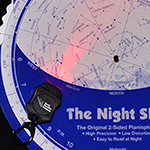Why the Red Light?
 Why do you need a red light to read your charts at night?
Why do you need a red light to read your charts at night?
It can take up to 45 minutes for the human eye to completely adapt to darkness. When you are in darkness the rod cells in your eyes begin to build up levels of a protein called Rhodopsin. This protein is what is responsible for your eyes “adapting” to the darkness. Once your night vision is adapted you might be surprised at how many more objects are visible. When your vision is well adapted you will also see more details in faint objects.
Unfortunately, your dark adaptation can be lost in a fraction of a second. Exposure to the bright white (and blue) light from a flashlight or a cell phone display can deplete Rhodopsin stores and leave you waiting around to adapt again! Have you have ever been to a star party where someone turned on headlights or a white flashlight? You probably witnessed lots of people hurriedly covering their eyes while crying out to the offender to “Turn out that light!”
Why Red Light Is The Answer
The low intensity, longer wavelength red light produced by our Night Reader Pro™ will not deplete your night vision. In your retina, light is detected by two types of cells. Rod cells are highly sensitive and responsible for low light vision. Cone cells are responsible for detecting color and for vision in bright conditions. Rod cells are not sensitive to the longer wavelength of red light produced by the Night Reader Pro™. Thus Rhodopsin stores in the rod cells will not be depleted as quickly leaving your dark adaptation intact. Your cone cells will readily detect the red light and allow you to read a planisphere or atlas without difficulty. This means you can look back and forth between a chart or atlas and the night sky without difficulty.
Intensity or Brightness
Another issue with astronomer’s lights is intensity. Even red light, if too bright for the application, can reduce your dark adaptation. A light that is bright enough to search an eyepiece case or walk around a dark site is probably too bright for closeup reading. The Night Reader Pro™ features an easy intensity adjustment and can be turned on at either full or minimum brightness, depending on your need. Once on, the Night Reader Pro™ can be adjusted to the perfect level for whatever your situation. Another important consideration is that the Night Reader Pro™ is a true astronomer’s LED flashlight. This means that it does not have a white light feature to accidentally activate while you and others are observing. We have all had that happen and it is highly embarrassing to say the least.

Follow Us!